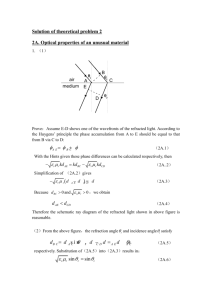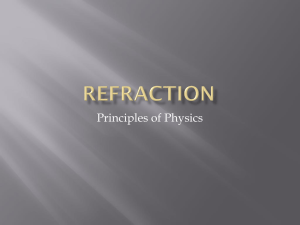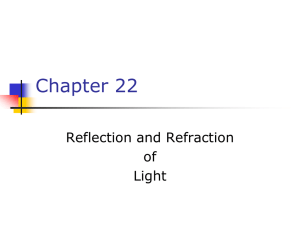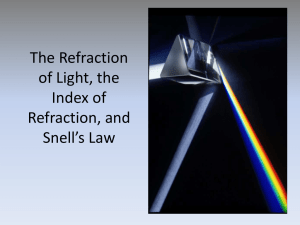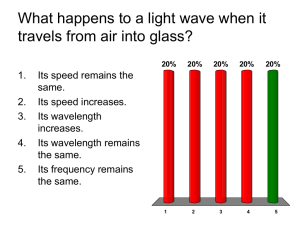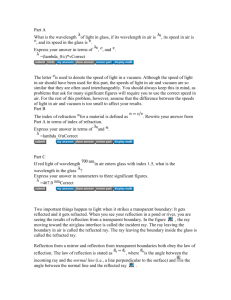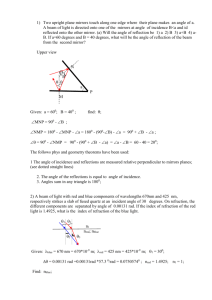Index of Refraction
advertisement
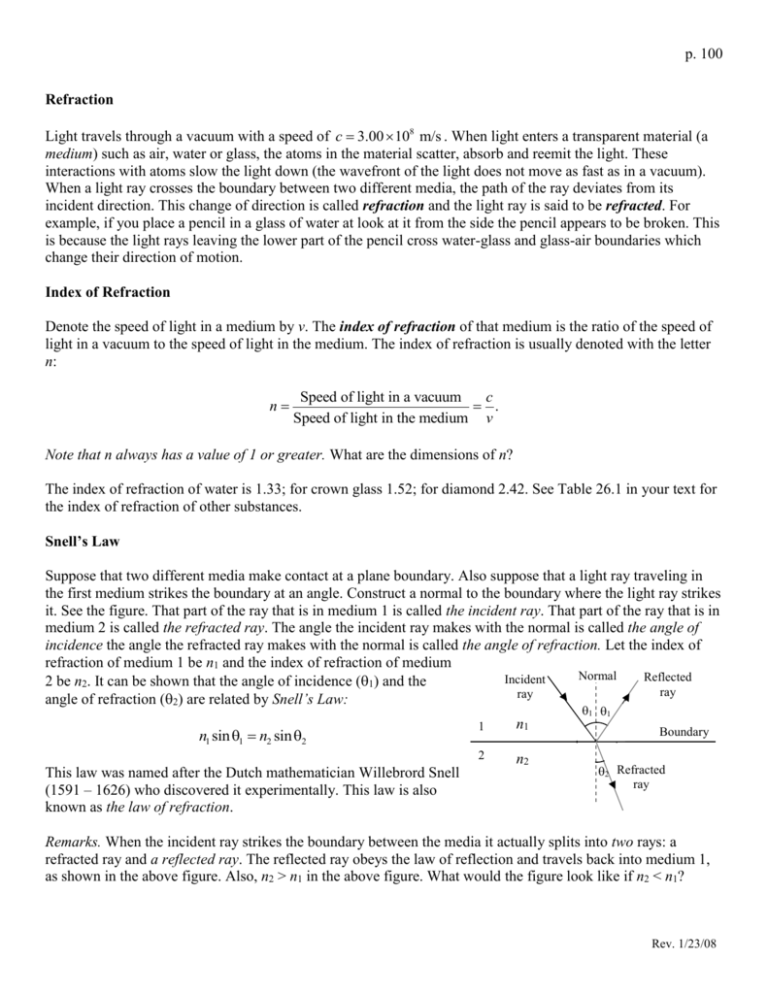
p. 100 Refraction Light travels through a vacuum with a speed of c 3.00 108 m/s . When light enters a transparent material (a medium) such as air, water or glass, the atoms in the material scatter, absorb and reemit the light. These interactions with atoms slow the light down (the wavefront of the light does not move as fast as in a vacuum). When a light ray crosses the boundary between two different media, the path of the ray deviates from its incident direction. This change of direction is called refraction and the light ray is said to be refracted. For example, if you place a pencil in a glass of water at look at it from the side the pencil appears to be broken. This is because the light rays leaving the lower part of the pencil cross water-glass and glass-air boundaries which change their direction of motion. Index of Refraction Denote the speed of light in a medium by v. The index of refraction of that medium is the ratio of the speed of light in a vacuum to the speed of light in the medium. The index of refraction is usually denoted with the letter n: n Speed of light in a vacuum c . Speed of light in the medium v Note that n always has a value of 1 or greater. What are the dimensions of n? The index of refraction of water is 1.33; for crown glass 1.52; for diamond 2.42. See Table 26.1 in your text for the index of refraction of other substances. Snell’s Law Suppose that two different media make contact at a plane boundary. Also suppose that a light ray traveling in the first medium strikes the boundary at an angle. Construct a normal to the boundary where the light ray strikes it. See the figure. That part of the ray that is in medium 1 is called the incident ray. That part of the ray that is in medium 2 is called the refracted ray. The angle the incident ray makes with the normal is called the angle of incidence the angle the refracted ray makes with the normal is called the angle of refraction. Let the index of refraction of medium 1 be n1 and the index of refraction of medium Normal Reflected Incident 2 be n2. It can be shown that the angle of incidence (1) and the ray ray angle of refraction (2) are related by Snell’s Law: 1 1 n1 sin 1 n2 sin 2 This law was named after the Dutch mathematician Willebrord Snell (1591 – 1626) who discovered it experimentally. This law is also known as the law of refraction. 1 n1 2 n2 Boundary 2 Refracted ray Remarks. When the incident ray strikes the boundary between the media it actually splits into two rays: a refracted ray and a reflected ray. The reflected ray obeys the law of reflection and travels back into medium 1, as shown in the above figure. Also, n2 > n1 in the above figure. What would the figure look like if n2 < n1? Rev. 1/23/08 p. 101 Example A light ray in a fish tank strikes the crown glass wall of the tank with an angle of incidence of 23. Find the angle of refraction of the ray in the glass. n1 sin 1 n2 sin 2 1.33sin 23 1.52sin 2 sin 2 1.33sin 23 1.52 ; sin 2 0.34; 2 20 Note that the refracted ray turns toward the normal. This is always the case if n2 > n1. Apparent Depth Because of refraction objects submerged in a liquid (such as water) are actually deeper than they appear to be. Consider the figure at the right. A light source submerged at depth d in a transparent liquid sends a light ray to the surface. For simplicity the reflected ray is omitted. Someone observing the source from above the surface, however, sees the object at depth d, which is smaller than d. n2 2 x 2 n1 1 1 d d x x and tan 2 . Thus d d d tan 1 d tan 2 (since both are equal to x). We see that tan 1 tan 1 . tan 2 This formula is generally true. However, if the angles of incidence and refraction of the light ray are small we may use the approximation tan sin ( small) so that so d d n tan 1 sin 1 sin 1 n2 . From Snell's law, and d d 2 , which is Equation 26.3 in the text. tan 2 sin 2 sin 2 n1 n1 Example Someone observing a fish tank from above sees a goldfish 2.00 cm beneath the surface. What is the actual distance of the goldfish from the surface? n 1.33 Solve the above equation for d: d d 1 ; d 2.00 cm ; d 2.66 cm. 1.00 n2 Keep in mind that Equation 26.3 is an approximation valid for small angles. If the angles are large, it gives just a rough estimate of the actual depth. p. 102 Derivation of Snell’s Law Remember that rays are used to show the path taken by electromagnetic waves. Ray optics works when the wavelength of the waves is much smaller than the objects the waves encounter. When an electromagnetic wave passes from one medium to another the wavefronts bend at the boundary. (See Figure 26.7a on p. 812 of your text.) Imagine the wavefronts as rows of marching soldiers. Let medium 1 in Figure 26.7a be dry ground where the soldiers march rapidly; let medium 2 be muddy ground where the soldiers march more slowly. The first figure on the right shows four soldiers marching on dry ground. The marching column is approaching the dry-mud boundary at an angle. It is clear that the soldier farthest to the left will reach the mud first. Dry Mud The second figure shows the soldier farthest to the left in mud, while the rest of the column is still on dry ground. The mud retards the soldier on the left; he is no longer marching as fast as the others in the column. This effect causes the line through the soldiers (the column line) to have a bend at the boundary. The third figure shows two soldiers in the mud while the remaining two are still on dry ground. The change in direction of the column’s path is now evident. The bend in the column line is now between the second and third soldiers. Three soldiers are now in the mud. Dry Mud Dry Mud Dry Mud The fourth soldier joins his comrades in the mud; the column line is straight again. However, the column line has changed direction and is moving more slowly than it did on the dry ground. Dry Mud p. 103 Now let us consider two successive wave fronts crossing the boundary between two media. Once again, the “faster” medium (smaller n) is on top and the “slower” medium (larger n) is on the bottom. Let h be the hypoteneuse common to the two large right triangles to the right of the normal line. Let v1 be the speed of light in medium 1 and v2 be the speed of light in medium 2. Finally, let f be the frequency of light (which is the same in both media). We see that n2 v v sin 1 1 , sin 2 2 . But since v f , 1 1 and 2 2 . h h f f so sin 1 1 1 n1 1 h 2 2 2 v1 v 1 1 1 , sin 2 2 or sin 1 sin 2 . fh fh v1 v2 fh Multiplying by c gives c c sin 1 sin 2 v1 v2 or n1 sin 1 n2 sin 2 , which is Snell's law. The Displacement of Light by a Transparent Material Suppose that a light ray in air passes into a long slab of transparent material with parallel surfaces. The incident ray and the ray that emerges from the opposite surface are parallel, but because of refaction in the material the emerging ray is displaced from the incident ray. The amount of displacement depends on 3 1. The angle of incidence. 2. The index of refraction of the material. 3. The thickness of the material. t 2 In the figure note that 3 = 1. (Why?) D 2 1 Total Internal Reflection When a light ray leaves a “slow” medium and enters a “fast” medium the ray bends away from the normal. The greater the angle of incidence, the greater the angle of refraction and the further the refracted ray bends away from the normal. In such situations it is possible to make the angle of incidence large enough so that the angle of refraction is 90. The angle of incidence that makes the angle of refraction 90 is called the critical angle; it is denoted by c. If the angle of incidence is greater than c there is no refracted ray in the second medium; the incident ray is completely reflected back into the incident medium. This phenomenon is called total internal reflection. The critical angle for two media can be determined from Snell’s law by setting 2 = 90: n1 sin 1 n2 sin 2 ; n1 sin c n2 sin 90; sin90 1 so sin c n2 n1 (n1 n2 ) c c p. 104 Example James Bond is swimming 3.00 m underwater with a flashlight. A guard is standing on an enemy boat 6.00 m in front of him. If Bond shines the flashlight at a point on the water that is 2.00 m in front of the boat, is it possible for the guard to see the beam? First find the angle of incidence of the flashlight’s beam with the water. (See the figure at the right.) 4 tan i ; i 53.1 3 Next find the critical angle for water: n 1 sin c 2 ; sin c 0.752; c 48.8 n1 1.33 i 3.00 m 4.00 m 2.00 m Since the angle of incidence of the beam exceeds the critical angle, the beam undergoes total internal reflection back into the water. Hence the guard cannot see the beam. Remark. Note that the above is an idealized situation.It is assumed that the beam from the flashlight is collimated, that is, all the rays in the beam are parallel. This is not true for ordinary flashlights, so it might be possible for some of the rays of the beam to be seen above water. In the above example we can assume that Mr. Bond is using one of his fancy gadgets: a highly-collimated waterproof laser flashlight issued to him by Qsection. Polarization by Reflection When unpolarized light strikes a nonmetallic surface with an angle of incidence greater than 0, the reflected light is at least partially polarized parallel to the surface. (Remember the polarization direction is taken to be the direction of oscillation of the electric field.) There is one special angle where the reflected light is completely polarized parallel to the surface; this angle is called the Brewster angle B. (This is named after the Scotsman David Brewster (1781 – 1868) who discovered it.) If the material is transparent to light, unpolarized light incident on the surface of the material at the Brewster angle is split into two rays: the refracted ray, which is partially polarized parallel to the surface and the reflected ray, which is completely polarized parallel to the surface. In his experiments, Brewster discovered that when light is incident at the Brewster angle, the refracted ray and the reflected ray make a 90 angle. Unpolarized light B n1 n2 From Snell's law n1 sin B n2 sin 2 but 2 B 90 (why?) so 2 90 B and n1 sin B n2 sin 90 B . Recall that sin A B sin A cos B sin B cos A : sin 90 B sin 90 cos B sin B cos 90 cos B : n1 sin B n2 cos B from which B sin B n2 n or tan B 2 . cos B n1 n1 The last equation above is called Brewster’s law. It is Equation 26.5 in the text. 2 Light polarized parallel to the surface Light partially polarized parallel to the surface p. 105 Example Find Brewster’s angle for a light ray in air striking a water surface. tan B 1.33 ; B arctan 1.33 ; B 53.1 1 Light striking the water at this angle produces reflected rays that are horizontally polarized. Polaroid sunglasses, when worn normally, have polarizing lenses with a vertical transmission axes. These sunglasses remove the horizontally-polarized components of reflected light, thereby reducing glare. Dispersion The theory of refraction presented so far is a very simple one; the refraction of light by matter is more complicated. (This is because the interaction of electromagnetic radiation with matter is complicated.) One complication is that the index of refraction of light depends on the light’s frequency. For example, in glass light with a higher frequency has a higher index of refraction. Thus for a given angle of incidence the angle of refraction of red light is less than that of violet light. This phenomenon is called dispersion. Because of dispersion a glass prism splits white light up into its component colors. The dispersion of light in water droplets is responsible for the appearance of a rainbow after a rain storm. Red light (450 THz) Incident white light Violet light (730 THz) Glass prism In addition to the dependency of the index of refraction on the frequency of radiation, there is an additional complication: the index of refraction can also depend on the direction the light is moving through the material. This phenomenon occurs in crystals such as Iceland spar (calcite, CaCO3). Crystals exhibiting this property are said to be doubly refracting or birefringent. A light ray incident on such a crystal is split into two refracted rays in the crystal; these refracted rays are linearly polarized in mutually perpendicular directions! In some doubly refracting crystals one of the polarized refracted rays is absorbed more strongly by the crystal than the the other. This phenomenon is called dichroism. The ray that emerges from the material is then strongly polarized in the direction perpendicular to that of the ray that was absorbed. Polaroid (a manufactured polarizing material) is made from many small dichroic crystals of iodoquinine sulfate embedded in a parallel arrangement in a plastic matrix. (This is the material used in the Polaroid sunglasses mentioned above.) A material whose properties are the same at all points is called homogeneous. A material whose properties are the same in all directions is called isotropic. Some materials (such as glass) are approximately homogeneous and isotropic. Real substances, in general, are neither homogeneous nor isotropic.
